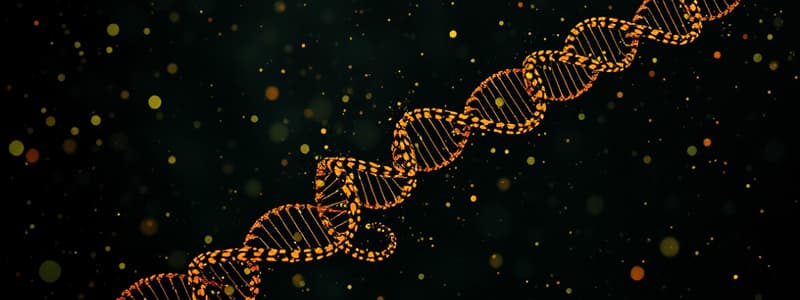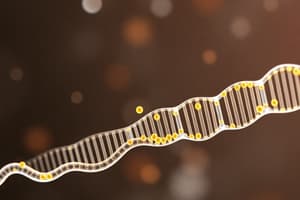Podcast
Questions and Answers
What is the primary focus of genomics?
What is the primary focus of genomics?
- Analysis of protein synthesis in cells
- Analysis of metabolic pathways in a cell
- DNA sequencing and understanding the full genome of an organism (correct)
- Analysis of mRNA levels in cells
Which omics technology analyzes the complete set of proteins synthesized by a cell?
Which omics technology analyzes the complete set of proteins synthesized by a cell?
- Proteomics (correct)
- Metabolomics
- Genomics
- Transcriptomics
How can metabolomics be utilized in biomedical research?
How can metabolomics be utilized in biomedical research?
- By sequencing DNA to identify SNPs
- By examining mRNA profiles to track cellular responses
- By quantifying the entire genome of an organism
- By analyzing the flux through metabolic pathways (correct)
What is a key application of transcriptomics?
What is a key application of transcriptomics?
What do single nucleotide polymorphisms (SNPs) help to correlate with?
What do single nucleotide polymorphisms (SNPs) help to correlate with?
Which described omics technology specifically targets lipids in a cell?
Which described omics technology specifically targets lipids in a cell?
What does proteomics reveal about cellular responses?
What does proteomics reveal about cellular responses?
What tool is commonly used in genomics for sequencing entire human genomes?
What tool is commonly used in genomics for sequencing entire human genomes?
What is the primary purpose of transcriptomics?
What is the primary purpose of transcriptomics?
What does cDNA stand for and why is it used?
What does cDNA stand for and why is it used?
What role do fluorescent labels play in the transcriptomics analysis?
What role do fluorescent labels play in the transcriptomics analysis?
In proteomics, what was the traditional method of analyzing proteins before more advanced techniques emerged?
In proteomics, what was the traditional method of analyzing proteins before more advanced techniques emerged?
What is a gene chip also known as?
What is a gene chip also known as?
Which technique is used for analyzing the proteins in a sample after 2-D gel electrophoresis?
Which technique is used for analyzing the proteins in a sample after 2-D gel electrophoresis?
What does SNP analysis primarily involve?
What does SNP analysis primarily involve?
Which factor can lead to different protein spots in a 2-D gel?
Which factor can lead to different protein spots in a 2-D gel?
What is the primary purpose of the extraction method in metabolomics?
What is the primary purpose of the extraction method in metabolomics?
Which technique is NOT typically used in the separative method of metabolomics?
Which technique is NOT typically used in the separative method of metabolomics?
What does the advantage of metabolomic analysis imply regarding drug interaction?
What does the advantage of metabolomic analysis imply regarding drug interaction?
Metabolomics can be particularly useful in diagnostics because it can build 'fingerprints' of which condition?
Metabolomics can be particularly useful in diagnostics because it can build 'fingerprints' of which condition?
How many endogenous metabolites are approximately detectable in the human body?
How many endogenous metabolites are approximately detectable in the human body?
What differentiates analysis of metabolites from RNA and Proteins?
What differentiates analysis of metabolites from RNA and Proteins?
In MS/MS, what is the second stage primarily designed to do?
In MS/MS, what is the second stage primarily designed to do?
Which phase of metabolomics analyzes the data collected from metabolites?
Which phase of metabolomics analyzes the data collected from metabolites?
Flashcards are hidden until you start studying
Study Notes
DNA Analysis and Genome Assembly
- Human genome comprises approximately 3.3 billion base pairs; full assembly and annotation demands extensive human resources.
- SNP comparisons to a reference genome can be executed in minutes, demonstrating the efficiency of genomic techniques.
Transcriptomics
- Involves analysis of mRNA to assess cellular responses to treatments such as drugs or virus infections.
- Isolation of mRNA is followed by conversion to cDNA, providing a stable DNA copy of mRNA.
- Fluorescent labels mark cDNA from different time points or treatments, enhancing hybridization to gene chips (microarrays) containing synthetic oligonucleotides.
Proteomics
- Focuses on the entire protein repertoire synthesized by a cell at a certain time, useful for revealing responses to external stimuli.
- Traditionally performed using 2-D gels; proteins are separated based on size and charge, then identified using techniques like LC-MS after digestion with trypsin.
Omics Technologies Overview
- Genomics employs DNA sequencing and recombinant DNA technologies to decode an organism's full genome.
- Metabolomics analyzes all metabolites in a cell, essential for pathway flux determination and diagnostics.
- Lipidomics assesses the lipid profile in cells, valuable for studying conditions like stroke, diabetes, and obesity.
Next Generation Sequencing (NGS)
- Utilizes advanced sequencing platforms (e.g., Roche 454, Illumina, PacBio) for rapid sequencing; allows for comprehensive SNP analysis.
- Single nucleotide polymorphisms (SNPs) highlight genetic variations correlating with diseases like Alzheimer’s, sickle cell anemia, and certain cancers.
Metabolomics Phases
- Extraction method preserves metabolites effectively.
- Separative techniques (gas chromatography, high pressure liquid chromatography, capillary electrophoresis) are used for metabolite separation.
- Identification of metabolites facilitated by mass spectrometry or NMR.
- Computational analysis aids interpretation of complex data sets.
Applications and Benefits of Metabolomics
- By comparing control and test samples, metabolomics can reveal disease consequences and establish metabolic fingerprints of various conditions.
- The technique offers insights into the biochemical effects of mutations and environmental changes, assisting in drug development and understanding side effects.
- Approximately 2,900 detectable endogenous metabolites exist in the human body, some related to previously uncharacterized gene functions.
Studying That Suits You
Use AI to generate personalized quizzes and flashcards to suit your learning preferences.




